|
|
|
ADVERTISEMENTS
|
|
PREMIUM
- HAPPY HOLIDAYS!
- Siliconeer Mobile App - Download Now
- Siliconeer - Multimedia Magazine - email-Subscription
- Avex Funding: Home Loans
- Comcast Xfinity Triple Play Voice - Internet - TV
- AKSHAY PATRA - Bay Area Event - Sat. Dec 6
- Calcoast Mortgage - Home Loans
- New Homes in Silicon Valley: City Ventures - Loden Place - Morgan Hill
- Bombay to Goa Restaurant, Sunnyvale
- Buying, Sellling Real Estate in Fremont, SF Bay Area, CA - Happy Living 4U - Realtor Ashok K. Gupta & Vijay Shah
- Sunnyvale Hindu Temple: December Events
- ARYA Global Cuisine, Cupertino - New Year's Eve Party - Belly Dancing and more
- Bhindi Jewellers - ROLEX
- Dadi Pariwar USA Foundation - Chappan Bhog - Sunnyvale Temple - Nov 16, 2014 - 1 PM
- India Chaat Cuisine, Sunnyvale
- Matrix Insurance Agency: Obamacare - New Healthcare Insurance Policies, Visitors Insurance and more
- New India Bazar: Groceries: Special Sale
- The Chugh Firm - Attorneys and CPAs
- California Temple Schedules
- Christ Church of India - Mela - Bharath to the Bay
- Taste of India - Fremont
- MILAN Indian Cuisine & Milan Sweet Center, Milpitas
- Shiva's Restaurant, Mountain View
- Indian Holiday Options: Vacation in India
- Sakoon Restaurant, Mountain View
- Bombay Garden Restaurants, SF Bay Area
- Law Offices of Mahesh Bajoria - Labor Law
- Sri Venkatesh Bhavan - Pleasanton - South Indian Food
- Alam Accountancy Corporation - Business & Tax Services
- Chaat Paradise, Mountain View & Fremont
- Chaat House, Fremont & Sunnyvale
- Balaji Temple - December Events
- God's Love
- Kids Castle, Newark Fremont: NEW COUPONS
- Pani Puri Company, Santa Clara
- Pandit Parashar (Astrologer)
- Acharya Krishna Kumar Pandey
- Astrologer Mahendra Swamy
- Raj Palace, San Jose: Six Dollars - 10 Samosas
CLASSIFIEDS
MULTIMEDIA VIDEO
|
|
|
|
|
TRAVEL:
An Ode to Science: Deutsches Museum, Munich
The Deutsches Museum in Munich is a huge complex dedicated to the history of science and technology and it is built around 12-miles of hallways with everything from a working textile mill to airplanes to automobiles to a full-size railroad center with engines, cars, buildings to the sciences and so much more, writes a visibly impressed Al Auger.
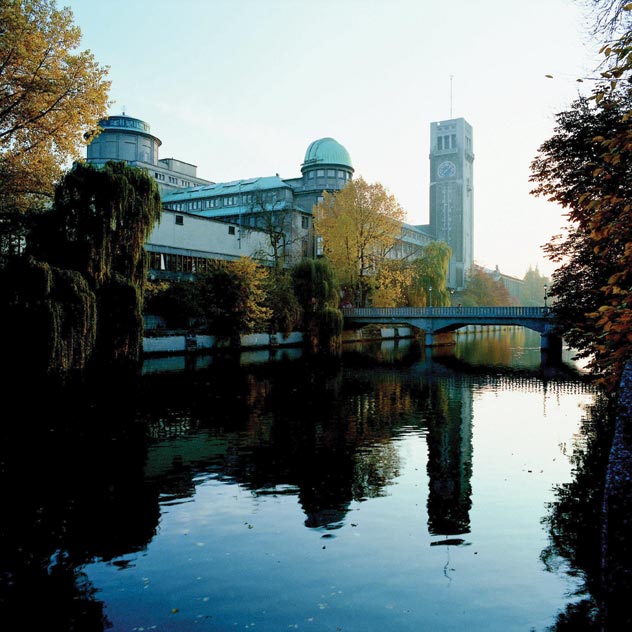
(Above): A picturesque exterior view of the Deutsches Museum near Germany’s Munich. [All photos: DEUTSCHES MUSEUM]
The Smithsonian may be the biggest and most eclectic museum in the world, but there is another that is awfully close to that title. Plus the additional charm of being a full tactile experience to enjoy. Just about every exhibit or collection is yours to operate, or walk through and learn by hands-on applications. This theater of the intellect and emotions is the famed Deutsches Museum outside of Munich, Germany.
The Deutsches sits on a solitary island where every inch, it seems, is a dedication to this edifice of the past, present and future. When my wife and I planned on checking out the museum, we had no idea what a gauntlet to time it presented. The whole complex is built around 12-miles of hallways with everything from a working textile mill to airplanes to automobiles to a full-size railroad center with engines, cars, buildings to the sciences and so much more. Turning to Plan B, we calculated three days to fully explore this vast and compelling monster.
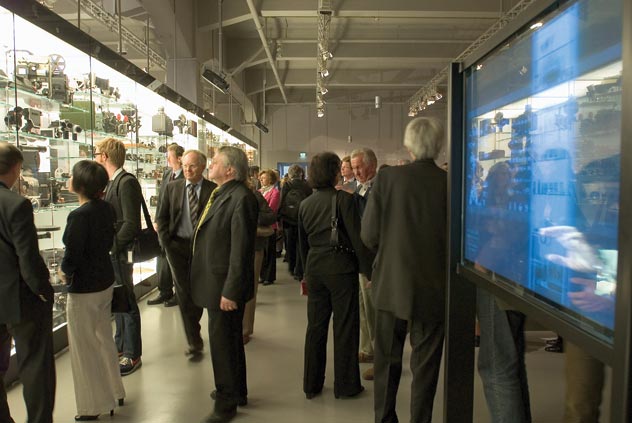
(Above): The Photo + Film exhibit was opened in 2007. Highlights from the area of photography and film from Daguerre to DVD are better explained by holographic touch screens.
We had found a large, beautifully landscaped campground on the edge of the inner city. We began, naturally, at the Marienplatz, Munich’s famed central plaza at the base of the Glockenspiel where mechanized figures dramatized the history of Bavaria. Wandering a crowded Marienplatz we finally asked a couple of senior citizens, resplendent in lederhosen and the requisites feathered hat, “Zee der sizt frei, bitte?” “Ah, ”one countered, “Ze are Amerikans. Ja, sitz, bitte.” Between conversing with the two friendly Germans, the music and the drama of the Glockenspiel and steins of refreshing Bavarian beer, we spent three glorious hours in our first day in Munich.
The next day we began our planned visit to the Deutsches Museum. As we always did in the larger towns and cities of Europe, we left our “four-wheeled home” at the campgrounds and searched out the way to the museum on local transit. As usual, Munich is another example of urban transit systems that are fast, on time and go just everywhere. (See sidebar for transportation information.)
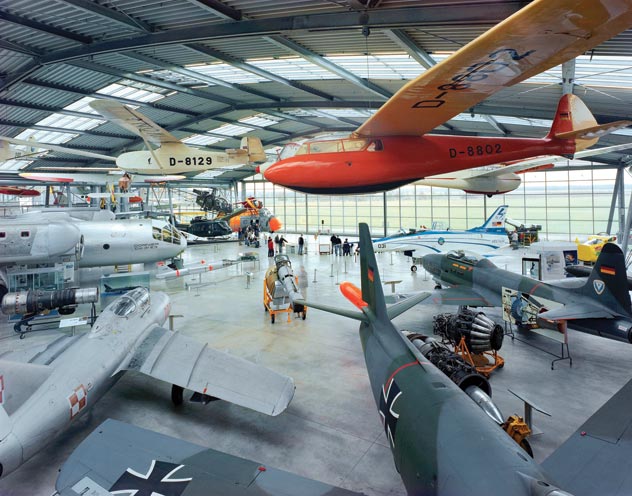
(Above): In 1992, the Flugwerft Schleissheim was opened on one of the oldest surviving airfields in Germany. Covering an area of 7800 sq meters with approximately 60 aircraft and helicopters, many hang gliding, aircraft engines, flight simulators, etc. are shown. In the glass hall, the restoration workshop is housed. From a gallery viewers can watch the conservators at their sophisticated work.
Not only are there a vast number of exhibitions and collections to view and be a part of, but throughout the multitude of subjects are various demonstrations to give a sense of reality and function. These include the casting of metals, the purpose of a high voltage plant, glass blowing and chemistry and the big show at the marvelous planetarium equipped by the optical genius of the 19th century, Karl Zeiss. Other side benefits include tours, lectures and films.
Although the layout describes six floors plus a basement, Europeans don’t count the ground floor numerically. Thus the first floor would be our second floor, so you have actually seven floors and the basement. There are over 40 rooms devoted to the sciences and technology of the world. The museum’s full title is a mouthful: Deutsches Museum Masterpieces of Natural Science and Technology.
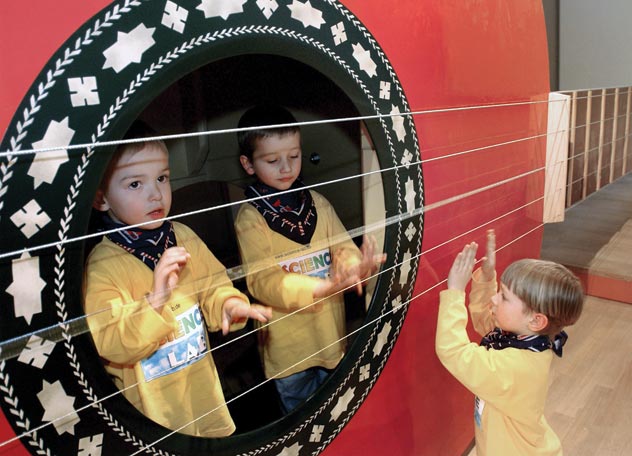
(Above): A walk-in guitar at the Kinderreich — children‘s world — in the Deutsches Museum. The children‘s world is a world of knowledge, with spacious play and learning areas for kindergarten or primary school children and their parents, helping build playful and imaginative connections with science and technology.
Founded in 1903 by Oskar von Miller, the museum was officially opened in 1906 in the former National Museum, Maximilianstrasse. It moved to the island Isarinsel in 1925. While there is a strong Teutonic flavor to many of the offerings, the world of science and technology is well presented. Unfortunately, there are so many entrancing stops along the myriad of hallways and so little room to describe them all; we can only highlight the main ones that buttonholed our imagination.
Being gearheads of the highest order, the automobile exhibit was our first stop. This is a wonderland of car stuff from the first automobile in the world to whole automobiles cut into sections to illustrate the building of a body and chassis. Race cars on the wall, race cars on the floor; engines, trannies, differentials, fuel systems and so much more. This is a kiddies paradise with all the automotive operating systems set up separately and operable by everyone. A great way to learn, for all ages, the mysteries of what makes a car go - and stop. Featured is the world’s first fully realized automobile, built by Karl Benz and debuted in 1896 and here you will find Karl Diesel’s original Diesel engine.
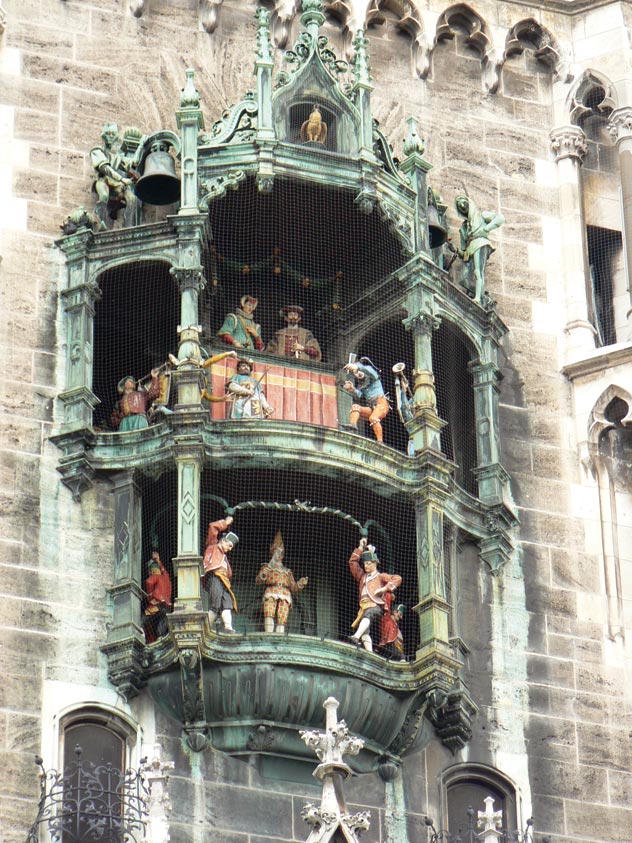
(Above): The Rathaus-Glockenspiel of Munich is a tourist attraction in Marienplatz the heart of Munich.
It dates from 1908. Every day at 11 a.m. (as well as 12 p.m. and 5 p.m. in summer) it chimes and re-enacts two stories from the 16th century to the amusement of mass crowds of tourists and locals. It consists of 43 bells and 32 life-sized figures. The whole show lasts somewhere between 12 and 15 minutes.
Beyond the automobile, mobility is covered throughout the museum with exhibitions of transportation of goods, urban transportation, the history of the railroad, the airplane and the meaning of all the systems and how they have affected our life, culture and avocations. Naturally, practically all the exhibits are open for hands-on inspection. Of particular interest to those with a mile-high temperament are the historical real-life airplanes and the opportunity to walk through many of the ancient and modern flying machines. The ceiling is full of aircraft including the first motorized aircraft built by the Wright brothers.
On the subject of kids, this is not your stuffy museum filled with only grownup toys and exotica. The children’s section is chock-a-block with touchy-feely goodies for “people with enquiring minds.” You can begin with the Technical Toys section and then on to the Children’s World and mechanical toys, the water-wave-weir or rock your soul with the giant guitar. The young visitors are enticed to make things, investigate technology toys and be entertained. For kids of all ages.
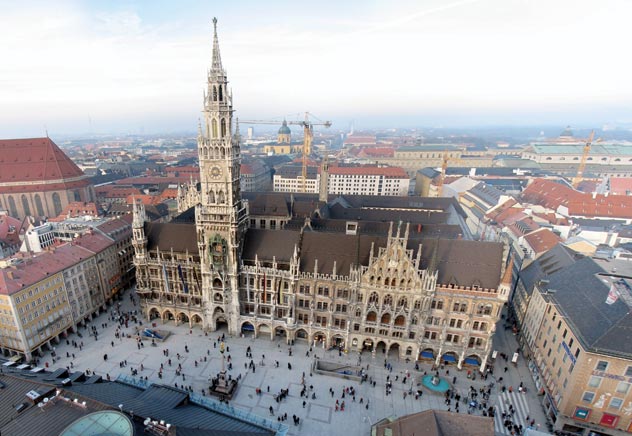
(Above): Marienplatz (Mary‘s Square, i.e. St. Mary, Our Lady‘s Square) has been the central square in the city center of Munich, Germany, since 1158.
Looking for the arcane? The special science room offers a broad swatch of the esoterica from research and technology. Another exhibition covers a subject so important today: energy. From the days man/woman first discovered fire, energy has been a most important element of our existence. The Deutsches Museum takes the visitor from the fire to modern windmill power.
For the rock and rollers there’s a seductive hall filled with musical instruments covering the story of electronic instruments and a new exhibit of musical automata.
How would you like to press a button and watch a giant press operate or fire-up a working textile mill or see an operable research laboratory? The physics exhibition covers the field of optics, electron microscopes and nuclear physics. Need to find out what a Foucault pendulum is? It’s here entirely in workable operation. There’s marine navigation, nano and biotechnology, food technology, computers, and more and more and more.
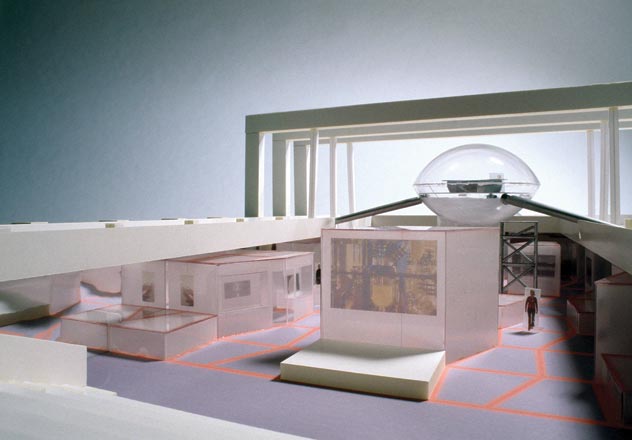
(Above): Model of the planned Zentrum Neue Technologien (The New Technologies Center ). The exhibition design conveys the fascination of research, with authentic original exhibits and realistic performances.
The final day should be closed with a trip to the stars and beyond in the museum’s world-famous Zeiss Planetarium and observatory. Museum founder Oskar Miller von Miller built the world’s first projection planetarium in 1925 utilizing the lenses of optical genius Karl Zeiss. Because of the length of the shows and being completely in the dark children under six years are not allowed.
The secrets of the Southern Hemisphere to the galaxies and planets are dramatically shown brilliantly on the unclouded star-studded planetarium sky. There are four tours a day; special tours in English for adults and preschool age children that can be reserved in writing eight days in advance. The museum charges an additional cost of two Euros per person.
The vast globe we populate is here for you; the copious collection will have you walking away filled with new wonderment about your life and the billions of lives on this planet.
BASIC INFORMATION
Address: Museumsinel 1, 80538 Munich, Germany
Telephone: 49 (0)89 / 2179-1
Website: deutsches-museum/en/information
City transportation
All S-Bahn lines to Isator station; Underground line U1 and U2 to Fraunhofer Strasse; bus 132 to Boschbruke; tram no. 18 to the Deutsches Museum, Tram no. 17 to Isator.
Auto travel is not recommended as parking is limited.
Admission
Day: 8.50 euros (16 years and
older) - Children (6-15) 3 euros - Under 6 free -
Seniors/Disabled 7 euros
Zeiss Planetarium: 2 euros (admission includes observatory) -
Evening lectures 3 euros.
Museum and Zoo combined: (block of ten patrons) 60 euros.
|
|
 Al Auger is a freelance writer. He lives in Redding, Calif. Al Auger is a freelance writer. He lives in Redding, Calif.
|
|
|
|
|
|